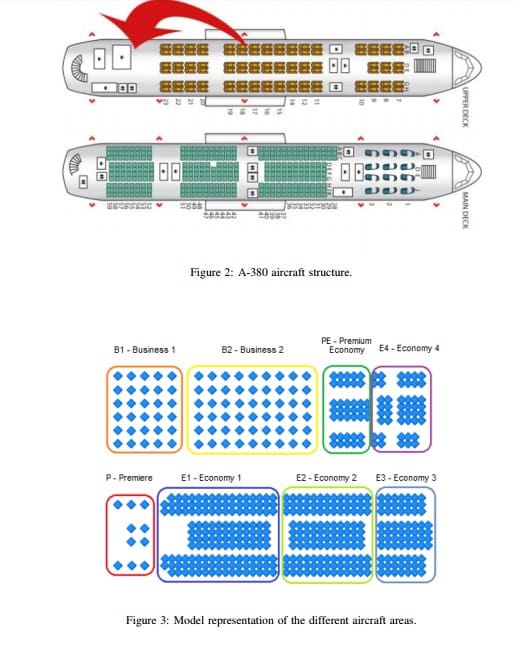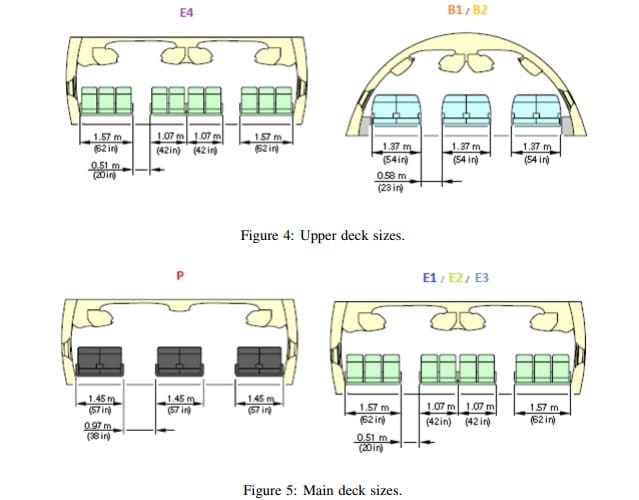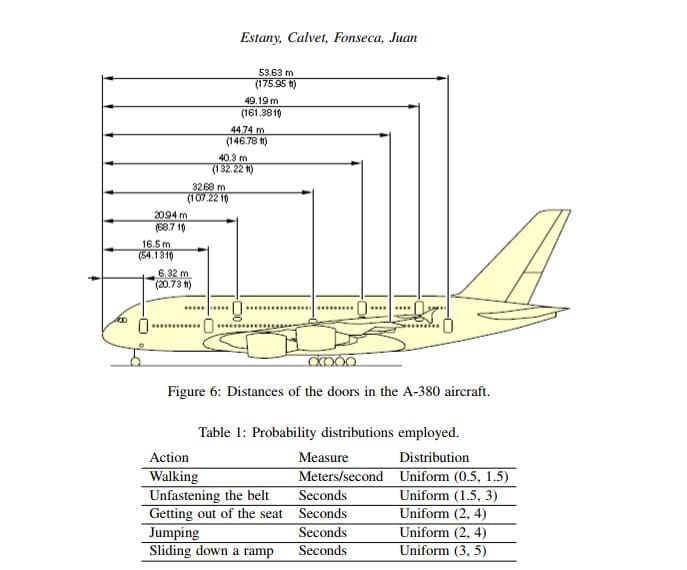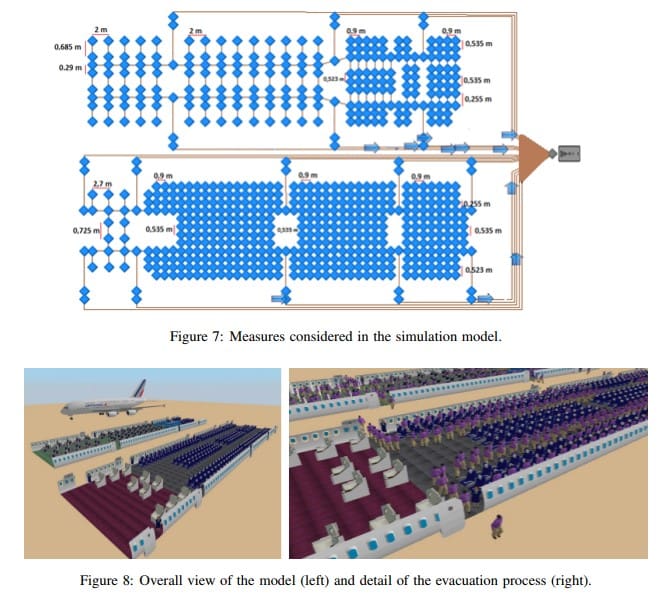1.2 Modeling
Statistics show that traveling by plane is one of the safest modes of transport. However, there may be risky situations such as going off track, an emergency landing, a terrorist threat or malfunctions that may require an emergency evacuation. The danger may come from impacts, fire, smoke, toxic gases or explosions. The commander is the responsible for starting the emergency evacuation, attempting to keep safe all the occupants. During the evacuation, the risks increase while the time passes by, so it is essential to minimize the evacuation time.
It has been proven that efficient emergency evacuation procedures are able to drastically reduce the number of victims in aircraft accidents with survivors. Accordingly, Air Control Centers (ACC) consider that these procedures and the ability to correctly apply them are extremely important for air security. In order to obtain the certification for an aircraft type, the manufacturer is required to perform a demonstration of emergency evacuation being completed in accordance with the airworthiness codes of its state. The ACC of the state is the responsible for giving this certification. The demonstration analyze the following:
- The basic design of the aircraft and its efficiency to evacuate passengers according to a given security level.
- The systems of emergency and evacuation.
- The emergency protocols and the evacuation procedures approved by the manufacturer.
The evacuation normative for aircraft is summarized in the European Aviation Safety Agency (EASA) Certification Specifications for Large Airplanes CS-25 (Amendment 4 – sec.28.803) and, for the United States, in the Code of Federal Regulations, Title 14 Aeronautics and Space, Chapter I Federal Aviation Administration, Department of Transportation. Every crew and passengers area requires enough emergency elements to allow a fast evacuation in emergency landings, with or without the landing gear deployed, considering that the aircraft may be on fire. For an aircraft with a capacity of more than 44 passengers, it is needed to assure that the maximum number of people, including the members of the crew, can be evacuated in less than 90 seconds under emergency conditions. The compliance of this requirement has to be demonstrated by means of a real simulation, using the test criteria indicated in the Appendix J of the CS-25, unless the agency finds a combination of analysis and testing that provides equivalent data.
This paper describes a simple yet realistic model to assess evacuation strategies. It employs the characteristics of the A-380 aircraft of the AirFrance company. The model enables the study of the passengers’ flow and the detection of potential bottle necks due to the accumulation of passengers in the areas close to emergency exits. A set of experiments is designed to analyze how the level of occupation and the proportion of doors inoperative affect the evacuation procedure in terms of time. The structure of the paper is as follows. Section 2 introduces related works. Afterwards, Section 3 defines emergency procedures. Section 4 presents the simulation model, discussing assumptions and implementation details. Section 5 explains the experiments carried out, and analyzes the results obtained. Finally, some conclusions and lines of future research are described in Section 6.
2 Literature Review
There are several studies that analyze risk factors on cabins. For example, Hsu and Liu (2012) discuss the risk factors related to their structure. Chang and Yang (2011) analyze passengers’ perceptions of the safety in a real accident. From these works, it can be concluded that both the procedures and the crew assistance are key elements for the evacuation process of an aircraft. Chang (2012) compares the safety of passengers with reduced mobility against regular passengers in case of accident. The former rely on the assistance provided by people accompanying them or the cabin crew during the evacuation procedures, and have a greater chance of getting wounded when an emergency arises due to their disabilities of movement (U.S. Department of Transportation 2009, U.S. Department of Transportation 2003).
An emergency constitutes a set of adverse events concentrated in a short period of time, which may cause anxiety and stress to passengers. These factors must be taken into account when analyzing evacuation processes, as the associated uncertainty may greatly alter the results. Indeed, the modeling of the passengers’ behavior tends to be an extremely difficult task, since it is influenced by a complex mixture of socio-psychological and physical factors (Poudel et al. 2005). In the field of pedestrian and evacuation, Helbing et al. (2002) compare the simulation of both normal and panic situations. The authors propose molecular-dynamic-like microsimulations based on a generalized force model of interactive pedestrian dynamics. According to them, the “nervousness” in panic situations significantly influences fluctuation strengths, desired speeds, and the tendency of herding. Additionally, paradoxial effects like “freezing by heating”, “faster is slower” and the ignorance of available exits are considered. Poudel et al. (2005) discuss the need for aircraft evacuation modeling as a consequence of the limitations inherent to real demonstrations (e.g., there is neither fire nor smoke, and children and disabled passengers usually do not participate). They argue that “real” evacuations may become very disorganized, with individuals competing to get through the exits. The authors suggest a fuzzy logic based approach which considers behavioral parameters such as situation awareness capability, physical state, mean response time to a new situation, free individual egress speed, and group links. Sharma et al. (2008) also analyze the human behavior in aircraft evacuations. They combine a social force model and a geometric model, and integrate fuzzy logic to consider the impact of factors such as panic and stress.
Chang and Yang (2011) analyze the perceptions of passengers regarding cabin safety from their emergency evacuation experiences in an aviation accident. The data was obtained by conducting questionnaire surveys and in-depth interviews to passengers of the company China Airlines. The authors conclude that passengers require more instructions on the use of emergency equipment and related protocols. Additionally, it is proven that the crew assistance and the emergency procedures are crucial for a correct evacuation. In Liao (2014), the tourism department of the Aletheia University (in Taiwan) presents a study to evaluate the education received by children from primary related to safety in aircrafts. The education program was designed on the basis of the safety instructions in the cabin. The children completed a survey before and after the course. The authors conclude that it is necessary to train the children to explain “what”, “when”, “how”, and “why” we should act in the event of an air accident. Television and the Internet are relevant resources to inform children (and people in general) on safety in cabin, but it may be more effective that an instructor teach students on these topics. Results show that the program was useful to improve children knowledge and attitudes, regardless of their school, location and experience in air travel. Cabin safety education is increasingly important due to the growing number of people traveling by plane. Moreover, the number of children traveling alone follows the same trend. In fact, the need for education related to cabin security has been discussed from both academic and practical perspectives (Chang and Liao 2008, Muir and Thomas 2004). However, few training programs have been developed. It is necessary to develop complete education programs, since they may increase the survival likelih
3 Emergency Procedures
The vast majority of emergencies occur during the phases of take-off and/or landing without any prior notice. These emergencies tend to be sudden and unexpected, giving little room to the crew and passengers to react.
3.1 Emergency Landing
An emergency landing may happen because of several factors. These may be external, such as adverse weather conditions, or internal, for example a power failure in one engine or technical failures of the aircraft. In this case, the commander transmits the information to the person in charge of the cabin as fast as possible, in order to forward the information to the rest of the cabin crew and the passengers. Subsequently, the crew gets ready for the emergency landing, following the corresponding protocols in a specific order, which are detailed in a list commonly called “checklist”.
Emergency landings may be preventive and not require an emergency evacuation. This depends on the commander criteria, who assesses the danger of the situation for the passengers and the crew. In an unexpected emergency landing there is no time to react. It happens when the aircraft undergoes a ‘real’ (i.e., not scheduled) emergency, and requires making a landing as fast as possible. The time for pilots and the crew to react is small, and have to quickly inform passengers.
3.2 Evacuation
The cabin crew has to be permanently ready to evacuate the aircraft in case of emergency, and to be alert to any sign of danger such as smoke, fire, sparks, or unusual noises. There are two types of evacuation movements: (i) planned, in which there is enough time to inform the passengers and the crew; and (ii) unexpected, in the other case. Figure 1 shows the safety information procedures for the A-380 aircraft.

4 Simulation Model
As commented before, the model is based on the A-380 airplane of the AirFrance company. The structure of the plane, which has two decks, is shown in Figure 2. The main deck is composed of 354 seats distributed in several spaces, 5 emergency exits on the right side and 5 on the left, and 10 emergency ramps (one per exit). The upper deck has 168 seats, 3 emergency exits on the right side and 3 on the left, and 6 emergency ramps.
Based on this structure, the model represents different areas as shown in Figure 3.
The main deck is composed by:
P → Travel class: “Premiere” (10 seats)
E0 → Travel class: “Seat Plus” (4 seats)
E1 → Travel class: “Economy 1” (144 seats)
E2 → Travel class: “Economy 2” (122 seats)
E3 → Travel class: “Economy 3” (74 seats)
The upper deck is composed by:
B1 → Travel class: “Business 1” (30 seats)
B2 → Travel class: “Business 2” (54 seats)
PE → Travel class: “Premium Economy” (38 seats)
E4 → Travel class: “Economy 4” (46 seats)
The measures introduced in the model are detailed for the upper and the main decks in Figures 4 and 5, respectively. Figure 6 reveals the distances from the front of the aircraft to each exit. These measures

are taken into account to distribute seats inside the cabins of the plane, and to create the routes that the passengers follow when accessing to the emergency exits.

The assumptions made in order to complete the description of the model are: (i) the distance between groups of seats is given by the length of a seat; (ii) the paths to the emergency exits define the routes followed by the passengers; and (iii) the length of the aisle is approximated from the information in Figure 6. The simulation model has been implemented with SIMIO c . Figure 7 includes all the measures considered. The lines connect the different elements of the model, defining the routes that passengers follow to exit the aircraft. A 3D representation (Figure 8) is used to validate and better understand the model, checking whether the paths followed by the passengers are the expected ones.
The evacuation of the Airbus 380 is an emergency strategy that must ensure that more than 500 passengers leave as fast as possible. The manufacturer designed two independent evacuation strategies, one per deck, avoiding the use of the internal stairs. Some experts would criticize this strategy because it does not take into account the fear that causes to a passenger having to jump through the emergency chutes or slides from a higher point. Thus, they would recommend an evacuation strategy combining the evacuation of the two plants. In this case, the difference is relatively small, 20 meters. The model considers five actions and defines a probability distribution for each one. This information is detailed in Table 1.







